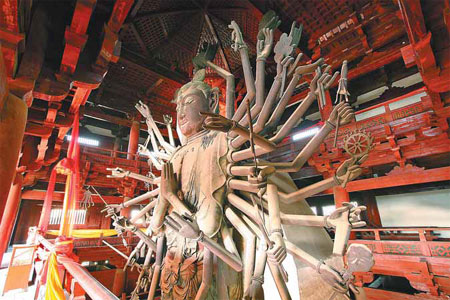 |
|
The Thousand Hands, Thousand Eyes Buddha is the biggest draw at Longxing Monastery in Shijiazhuang. Photos Provided to China Daily
|
Modern visitors to the ancient town of Zhengding discover Longxing's Big Buddha is an exceptional figure - but ultimately an idiosyncratic entity that dwells in a settlement packed with peculiarities.
What has nine heads, 42 arms and is 21 meters tall?
The answer isn't the punch line to a lame joke but rather the incredible statue that gives the Longxing Monastery its other appellation - the Big Buddha Temple.
The country's largest bronze Buddha is also known as the Thousand Hands, Thousand Eyes Buddha - a misnomer by virtue of exaggeration but a namesake that nonetheless hails its uniqueness. The Song Dynasty (AD 971) statue's bronze arms were destroyed in 1780 but later restored by believers.

Yet the sculpture is only one of myriad religious rarities housed by the holy site in Hebei province's ancient Zhengding city (then the province's capital), about 15 km outside the provincial capital Shijiazhuang.
Longxing ranks among the country's best-preserved temples because it was a stopover for emperors undertaking pilgrimages to the Wutai Mountains, giving the compound yet another title - the First Temple South of Beijing.
That's perhaps the reason it hosts so many sacred peculiarities.
An amazing trove of artifacts survived from Longxing's construction in the Sui Dynasty (AD 581-618), especially those from after the Song revamped the compound. One of the oldest surviving artifacts is the Longcang Temple Stele, hailed as "the First Stele of the Sui Dynasty". It's actually China's oldest.
An especially striking specimen from the period immediately following the reconstruction is a 10.8-meter octagonal rotating sutra bookshelf that's 7 meters in diameter. It's the oldest and largest of a handful that remains and offers insight into Song technology.
A 1,000-year-old 7.4-meter-tall Buddha carved from a single tree is unique in that it's exceptionally slender and stands rather than sits.
Another celebrated sculpture is unparalleled in that it depicts "China's most beautiful Guanyin" at her "most casual". The Goddess of Mercy reclines whimsically in stark contrast to her otherwise rigid depictions in the only known such rendering in dynastic history.
But there's a potentially unnerving dimension of Guanyin's laidback side - her gaze seems to follow you as you walk. Some consider her wandering eyes playful. Others call them creepy.
We recommend:
